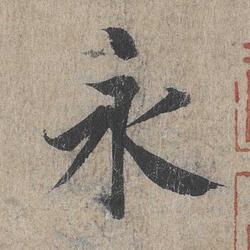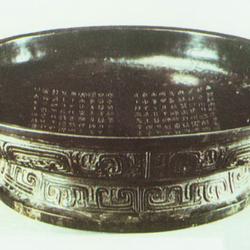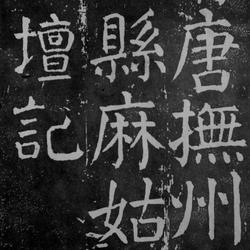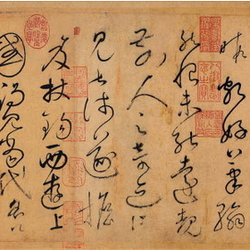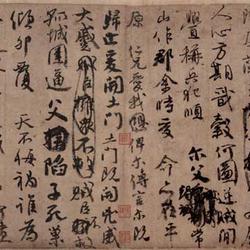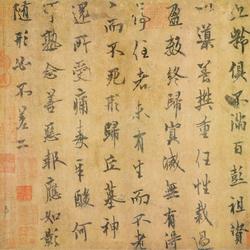Northern Song Dynasty - Su Shi's "Huangzhou Cold Food Post" - the third running script in the world
【name】Huangzhou cold food post
[Category] Ancient Chinese Dharma Books
【Author】Su Shi
【Form】Paper
【Era】Northern Song Dynasty
[Original size] 34 cm vertical, 119.5 cm wide
[Finished product size] 34 cm in length, 506.5 cm in width
[Current Situation of Cultural Relics] Taipei National Palace Museum
Overview of the main posts of "Huangzhou Cold Food Post":

Details of the original post:
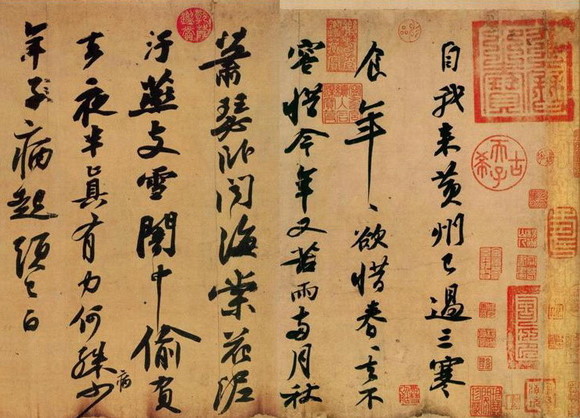
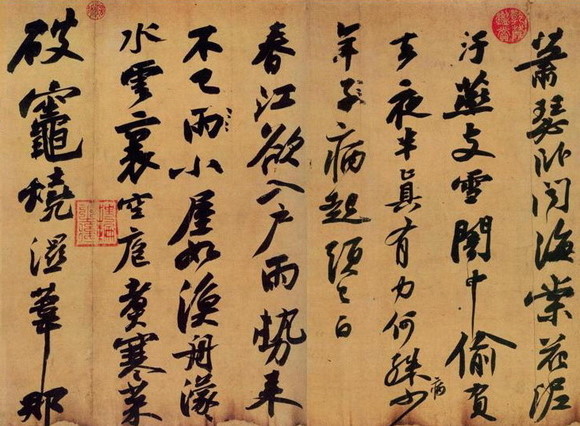
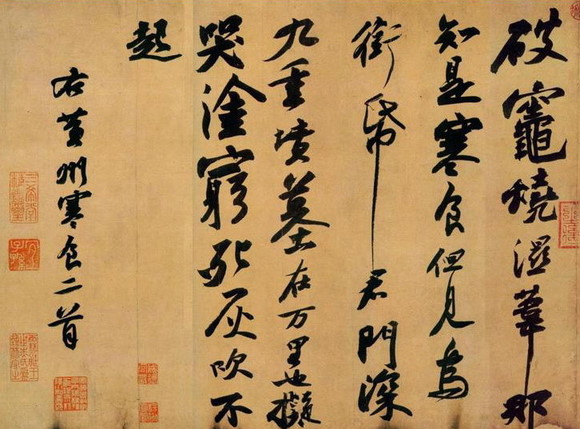
original:
Since I came to Huangzhou, three cold seasons have passed. I want to cherish spring every year, but I don’t want to miss it when it is gone. This year it rained hard again, and autumn was bleak in two months. I lie down and smell the begonia flowers, the muddy swallows are covered with snow. Sneak it away in secret, it's really powerful in the middle of the night. Heshu is a young boy, and his hair has turned white since he was sick. Spring River is about to enter the house, but the rain keeps coming. The hut is like a fishing boat, in the misty water and clouds. The empty kitchen is used to cook cold vegetables, and the broken stove is used to burn wet reeds. I didn't know it was cold food, but I saw a bird holding a piece of paper. The king's gate is nine levels deep, and his tomb is thousands of miles away. I also want to cry that I have no way out and can't afford to die.
[Description of the work]
In February of the third year of Yuanfeng (1080), Su Shi was forty-five years old. He was ostracized by the New Party due to the "Wutai Poetry Case", the largest literary prison in the Song Dynasty, and was demoted to the deputy envoy of Tuanlian in Huangzhou (now Huanggang, Hubei). He felt mentally lonely and depressed. Unable to achieve his ambitions and living in poverty, he wrote these two cold food poems in April of the third year of the Song Dynasty, which was the fifth year of Yuanfeng (AD 1082) of Emperor Shenzong of the Song Dynasty. This volume was written probably in the following year, or when he left Huangshan in the seventh year of Yuanfeng. After the state. In the third year of Yuanfu (1100), the collector Zhang of Shuzhou took it and invited Huang Tingjian to view it and write an inscription and postscript, which can be said to complement the original work.
Connoisseurs of all ages have highly praised "Han Shi Tie" and praised it as a masterpiece. In the early years of the Southern Song Dynasty, Zhang Hao's great-nephew Zhang Yan wrote in a postscript on a separate sheet of paper after the poem: "The old immortal (referring to Su Shi) has a superb writing style, as bright as the sky and clouds, and the valley (referring to Huang Tingjian) has carried it forward again. It can be said that Unparalleled treasure." Since then, the poem draft "Two Poems on Cold Food in Huangzhou" has been called "Tie". Dong Qichang, a great calligrapher and painter of the Ming Dynasty, wrote at the end of the post: "I have seen no less than thirty volumes of Mr. Dongpo's original works for the rest of my life, and I must take this as my first impression." In the Qing Dynasty, "Hanshi Tie" was taken back to the inner palace and included in "Sanxitang Tie". On the eighth day of April in the thirteenth year of Qianlong's reign (1748), Emperor Qianlong personally wrote a postscript on the back of the post: "Dang Xiuyi, a scholar from Dongpo, was one of the empresses Yan and Yang. This volume was written by someone who was banished to Huangzhou, and there is a valley postscript at the end. I'm so overwhelmed, it's said that it's better to be good than to be unintentional..." To highlight the past, the four words "The Aftertaste of Snow Hall" are written at the beginning of the volume.
"Huangzhou Cold Food Poems" shows the momentum and is filled with ups and downs of emotions. The poem is desolate and melancholy, and the calligraphy was inspired by this mood and situation. The whole article is full of ups and downs, fast and steady, full of joy, and completed in one go. Su Shi embodies the changes in mood and emotion in the poems in the changes of pointillism lines, either front or side, changing and disconnecting smoothly, making it natural. The characters are also strange, big or small, sparse or dense, light or heavy, wide or narrow, staggered and scattered, random and strange, and ever-changing. Because of the praise and praise from various schools, the world collectively called "Han Shi Tie" together with "Lanting Preface" by Wang Xizhi of the Eastern Jin Dynasty and "Manuscript of Sacrifice to My Nephew" by Yan Zhenqing of the Tang Dynasty as "the three major running scripts in the world", or simply called "Han Shi Tie" as "Han Shi Tie". The third running script in the world." Some people compare the "three major running scripts in the world" and say: "Lanting Preface" is the style of an elegant scholar and superman, "Memorial to Nephew" is the style of a wise man, and "Han Shi Tie" is the style of a scholar and a talented person. . They are comparable to each other one after another, each taking the lead. They can be regarded as three milestones in the history of Chinese calligraphy.
【Anecdotes of Dharma Tie】
This volume was collected by Feng, a Cantonese, during the Tongzhi period (1862~1874). It suffered a fire, so there are traces of fire on the lower end. It was collected by Japanese collector Kikuchi Hōtō in 1922, returned to a collector in Taipei around 1949, and was purchased back by the National Palace Museum in Taipei in 1987.
In modern times, "Han Shi Tie" had an ill-fated fate. In 1860, the tenth year of the reign of Emperor Xianfeng of the Qing Dynasty (1860), the British and French forces burned down the Old Summer Palace, and "Han Shi Tie" was almost burned. It was immediately sold to the people and was acquired by Feng Zhanyun. After Feng's death, it was secretly kept by Sheng Boxi. After Sheng's death, it was purchased by Wanyan Pusun. It was purchased by Wanyan Pusun in 1917. It was exhibited at the Beijing Painting and Calligraphy Exhibition and received close attention from the painting and calligraphy collection community. It was transferred to Yan Yunbo in 1918. December 19th of that year was Su Shi's birthday, and Yan Yunbo wrote a postscript to record the whole story. In 1922, when Yan Yunbo visited Tokyo, Japan, he sold "Han Shi Tie" to the Japanese collector Kikuchi Xingtang at a high price. In September 1923, the great earthquake in Tokyo, Japan, devastated the Kikuchi family, and almost all the calligraphy and paintings of ancient celebrities were destroyed. At that time, Kikuchi Xingtang risked his life to rescue "Han Shi Tie" from the fire, which became a good story. . After the earthquake, Kikuchi Hōtō hid the "Han Shi Tie" in his friend Naito Torasai's middle age. In April 1924, at the request of Kikuchi Hōdou, Naito Tora wrote a postscript to record the general circumstances of the "Hanshi Tie" being transferred from China to Japan. During World War II, Tokyo was repeatedly bombed by the U.S. Air Force, but "Han Shi Tie" was fortunately unharmed.
The loss of "Han Shi Tie" overseas has always made Chinese descendants deeply worried. Immediately after the Second World War, Wang Shijie, Minister of Foreign Affairs of the Nationalist Government, privately asked his friends to search for "Han Shi Tie" in Japan. When he found out its whereabouts, he bought it back with a large sum of money and put an inscription on the back of the post, outlining its loss to Japan and its transfer from Japan. The general process of returning to China. Thanks to the efforts of Mr. Wang Shijie, the thousand-year-old national treasure returned to the motherland and is still treasured in the National Palace Museum in Taipei.
More than ten years later, a 7.3-meter-long scroll replica of "Han Shi Tie" was exhibited at a calligraphy and painting exhibition in Taipei. It caused a sensation and everyone who saw it was amazed. It is said that there are only 10 such replicas, most of which are collected by internationally renowned national museums, and the whereabouts of two are unknown. Around 1975, Yamajiro, a well-known "Dongpo fan" among his Japanese friends, spent a huge sum of money to buy the last replica in the Taipei exhibition hall. On November 2, 1985, Yamajiro led the Japanese "Dongpo Visiting Group" to Dongpo Red Cliff in Huangzhou. Out of his admiration for Su Shi and his love for Dongpo Red Cliff, Yamajiro bought it at a high price. The last scroll copy of "Han Shi Tie" was donated to the Dongpo Chibi Management Office, making this copy the only treasure in mainland China. In 1995, at the initiative of Yamajiro, the "Sino-Japanese Friendship House" was built in Red Cliff on the east slope, and a replica of the "Han Shi Tie" scroll was publicly displayed for the first time.
On April 6, 1995, in order to promote the art of Chinese calligraphy, Taiwan's postal department issued a set of 4 special 346 "Cold Food Post" stamps, printed in four consecutive horizontal sheets, with 4 sets of stamps in full, and Huang Tingjian printed on the margin. "Postscript to Cold Food Poems". At the end of the same year, Huangzhou Zhongxing Industrial Group Co., Ltd. also launched two "Huangzhou Chibi" corporate New Year greeting cards. The second one (No. 1996 Hubei (BK)-0003) has the main picture of "Cold Food Post" (part of it) ). As soon as these two exquisite stamps came out, they became the targets of philately and calligraphy enthusiasts at home and abroad. It is coincidental and inevitable that mainland China and Taiwan issue "Han Shi Tie" stamps (products) at the same time. Because both sides of the Taiwan Strait have the same roots and culture, there is only one Su Dongpo who has outstanding talents and ambitions for EMI!
【About the Author】
Su Shi (January 8, 1037 - August 24, 1101), also known as Zizhan and Hezhong, was also known as "Dongpo Jushi", and the world called him "Su Dongpo". Han nationality, a native of Meizhou (now Meishan, Sichuan, Meishan City in the Northern Song Dynasty), and his ancestral home is Luancheng. He was a famous writer, calligrapher, painter, lyricist, poet, and gourmet in the Northern Song Dynasty. He was one of the eight great writers of the Tang and Song Dynasties and a representative of the Bold and Unconstrained poets. His poems, lyrics, Fu and prose are all of high achievement, and he is good at calligraphy and painting. He is a rare all-rounder in the history of Chinese culture and one of the most outstanding people recognized for their literary and artistic attainments in China's thousands of years of history. His prose is called Ou Su together with Ouyang Xiu; his poems are called Su Huang together with Huang Tingjian; his poetry is called Su Xin together with Xin Qiji; his calligraphy is listed as one of the four major calligraphers of the Northern Song Dynasty: "Su, Huang, Mi, and Cai"; his paintings are pioneers. Huzhou School of Painting.

